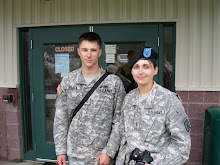
Matt and Cyndi - JRTC Aug 5th-29
http://www.jrtc-polk.army.mil/AboutJRTC.htm
ABOUT JRTC
Forging the Warrior Spirit
The Joint Readiness Training Center (JRTC) is focused on improving unit readiness by providing highly realistic, stressful, joint and combined arms training across the full spectrum of conflict (current and future).
The JRTC is one of the Army’s three “Dirt” Combat Training Centers resourced to train infantry brigade task forces and their subordinate elements in the Joint Contemporary Operational Environment.
With great emphasis on realism, the JRTC provides rotational units (BLUEFOR) with the opportunity to conduct joint operations which emphasize contingency force missions. The JRTC training scenario is based on each participating organization's mission essential tasks list and many of the exercises are mission rehearsals for actual operations the organization is scheduled to conduct.
JRTC scenarios allow complete integration of Air Force and other military services as well as host-nation and civilian role players. The exercise scenarios replicates many of the unique situations and challenges a unit may face to include host national officials and citizens, insurgents and terrorists, news media coverage, and non-governmental organizations.
Observer/Controllers (O/C) help make JRTC training effective. The O/C's have a duty to the training unit and the Army to observe unit performance, control engagements and operations, teach doctrine, coach to improve unit performance, monitor safety and conduct professional After Action Reviews (AARs). O/C's are required to have successfully performed the duties of their counter-part. They constantly strive for personal and professional development, and are well versed in current operational doctrine and tactics, techniques and procedures.
AARs provide immediate feedback for each element, from platoon through brigade task force. AAR's provide impartial feedback, that encourage interaction and discussion of unit strengths and weaknesses by all members of the unit. Every AAR orients on a specific mission and /or system, identifying good and bad trends, and provides units the opportunity to determine not only what their weaknesses are, but who is going to fix that weakness.
http://en.wikipedia.org/wiki/Fort_Polk
http://www.jrtc-polk.army.mil/AboutJRTC.htm
ABOUT JRTC
Forging the Warrior Spirit
The Joint Readiness Training Center (JRTC) is focused on improving unit readiness by providing highly realistic, stressful, joint and combined arms training across the full spectrum of conflict (current and future).
The JRTC is one of the Army’s three “Dirt” Combat Training Centers resourced to train infantry brigade task forces and their subordinate elements in the Joint Contemporary Operational Environment.
With great emphasis on realism, the JRTC provides rotational units (BLUEFOR) with the opportunity to conduct joint operations which emphasize contingency force missions. The JRTC training scenario is based on each participating organization's mission essential tasks list and many of the exercises are mission rehearsals for actual operations the organization is scheduled to conduct.
JRTC scenarios allow complete integration of Air Force and other military services as well as host-nation and civilian role players. The exercise scenarios replicates many of the unique situations and challenges a unit may face to include host national officials and citizens, insurgents and terrorists, news media coverage, and non-governmental organizations.
Observer/Controllers (O/C) help make JRTC training effective. The O/C's have a duty to the training unit and the Army to observe unit performance, control engagements and operations, teach doctrine, coach to improve unit performance, monitor safety and conduct professional After Action Reviews (AARs). O/C's are required to have successfully performed the duties of their counter-part. They constantly strive for personal and professional development, and are well versed in current operational doctrine and tactics, techniques and procedures.
AARs provide immediate feedback for each element, from platoon through brigade task force. AAR's provide impartial feedback, that encourage interaction and discussion of unit strengths and weaknesses by all members of the unit. Every AAR orients on a specific mission and /or system, identifying good and bad trends, and provides units the opportunity to determine not only what their weaknesses are, but who is going to fix that weakness.
http://en.wikipedia.org/wiki/Fort_Polk





No comments:
Post a Comment
Note: Only a member of this blog may post a comment.